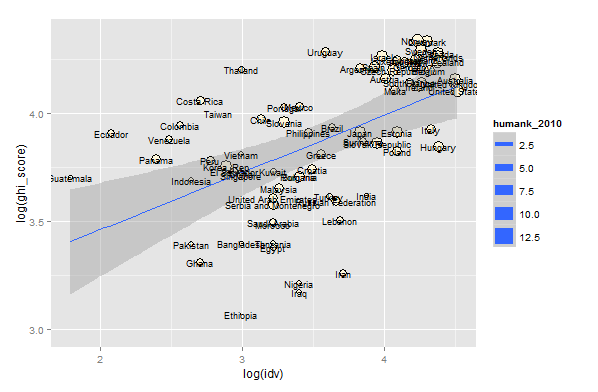Como sabemos, as dimensões culturais de Hofstede são úteis para algumas investigações sobre valores informais (no dizer de Douglass North) e desenvolvimento econômico. Ora bolas, no final, queremos mais bem-estar, não é mesmo?
Vamos dar uma olhadinhas em quatro das dimensões? Citando da Wikipedia em língua inglesa (negritos meus, ok?):
- Power distance index (PDI): “Power distance is the extent to which the less powerful members of organizations and institutions (like the family) accept and expect that power is distributed unequally.” Individuals in a society that exhibit a high degree of power distance accept hierarchies in which everyone has a place without the need for justification. Societies with low power distance seek to have equal distribution of power.[6]Cultures that endorse low power distance expect and accept power relations that are more consultative or democratic.
- Individualism (IDV) vs. collectivism: “The degree to which individuals are integrated into groups”. In individualistic societies, the stress is put on personal achievements and individual rights. People are expected to stand up for themselves and their immediate family, and to choose their own affiliations. In contrast, in collectivist societies, individuals act predominantly as members of a lifelong and cohesive group or organization (note: “The word collectivism in this sense has no political meaning: it refers to the group, not to the state”). People have large extended families, which are used as a protection in exchange for unquestioning loyalty.
- Uncertainty avoidance index (UAI): “a society’s tolerance for uncertainty and ambiguity“. It reflects the extent to which members of a society attempt to cope with anxiety by minimizing uncertainty. People in cultures with high uncertainty avoidance tend to be more emotional. They try to minimize the occurrence of unknown and unusual circumstances and to proceed with careful changes step by step planning and by implementing rules, laws and regulations. In contrast, low uncertainty avoidance cultures accept and feel comfortable in unstructured situations or changeable environments and try to have as few rules as possible. People in these cultures tend to be morepragmatic, they are more tolerant of change.
- Masculinity (MAS), vs. femininity: “The distribution of emotional roles between the genders“. Masculine cultures’ values are competitiveness, assertiveness, materialism, ambition and power, whereas feminine cultures place more value on relationships and quality of life. In masculine cultures, the differences between gender roles are more dramatic and less fluid than in feminine cultures where men and women have the same values emphasizing modesty and caring. As a result of the taboo on sexuality in many cultures, particularly masculine ones, and because of the obvious gender generalizations implied by Hofstede’s terminology, this dimension is often renamed by users of Hofstede’s work, e.g. to Quantity of Life vs. Quality of Life.
Ok, o que eu esperaria? Eu esperaria que a felicidade gay tivesse uma relação negativa com PDI, positiva com IDV, negativa com MAS e, quanto a UAI, eu não tenho uma hipótese inicial muito clara, não sei bem o que esperar (acredite, leitor, eu fiz as hipóteses antes de olhar para os gráficos…).
Ah sim, eu também esperaria que a felicidade dos não-gays também tivessem relações similares, mas não vou calcular estas correlações aqui porque não tenho os dados acerca dos percentuais de gays e não-gays nos países.



 Bem, qual não foi minha surpresa quando vi que as correlações ficaram mais ou menos parecidas com o que eu esperava. Mais ainda, as medidas de Hofstede parecem ser razoáveis indicadores de valores informais (ou culturais) de uma sociedade, não?
Bem, qual não foi minha surpresa quando vi que as correlações ficaram mais ou menos parecidas com o que eu esperava. Mais ainda, as medidas de Hofstede parecem ser razoáveis indicadores de valores informais (ou culturais) de uma sociedade, não?
Minha ex-aluna Charline, há algum tempo, fez-me o favor de tabular estes dados (refiro-me ao Hofstede) e devo agradecê-la por isso pois sempre que penso em estudar um problema institucional (meus leitores sabem que sou um entusiasta da história econômica tal como preconizada por Douglass North e colegas, né?), acabo usando estas variáveis para ter uma noção inicial do problema.
De qualquer forma, no post anterior, falei do porte de armas como uma proxy de liberdade individual. Sei que é polêmico, mas a intenção era mesmo chamar a atenção (a minha também) para o problema das instituições. A bem da verdade, o que está no âmago da discussão sobre bem-estar e instituições é a questão da dinâmica institucional (como as instituições mudam). Vejam o caso do casamento gay nos EUA, por exemplo. Será que estas mudanças têm a ver com valores (que não são necessariamente rígidos) de uma sociedade?
Repare como, novamente, as mesmas instituições que suportam uma liberdade econômica (como a liberdade de trocas voluntárias que é, essencialmente, uma dimensão individualista e que requer confiança – trust – entre as partes) também suportam a felicidade da turma LGBT. Suspeito, cada vez mais, que os maiores entusiastas do liberalismo ainda não saíram do armário. Será que existe uma discriminação de gays coletivistas contra gays liberais? Eu tenho um palpite, mas vamos deixar para outro dia.
p.s. Nos gráficos, o “humank_2010” é uma medida de capital humano (educação, para os leigos…). Quanto maior o tamanho da bolinha, maior o nível de capital humano do país.

Um comentário em “Gays são mais felizes em países mais coletivistas? Em países mais individualistas? Mais um pouco de correlações para sua reflexão.”